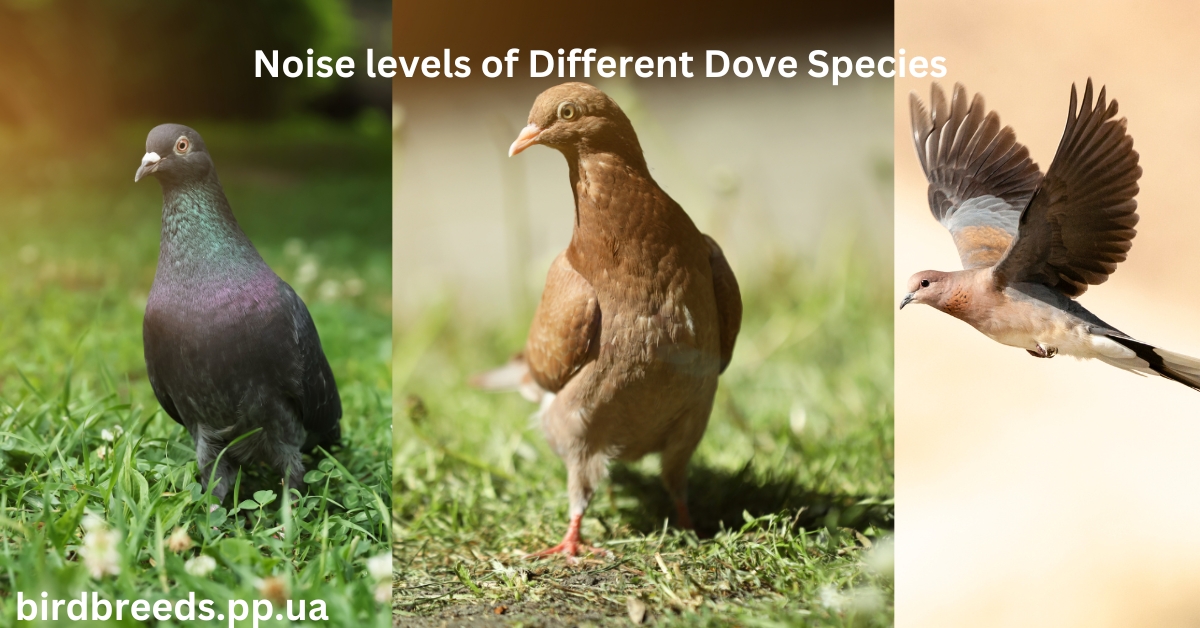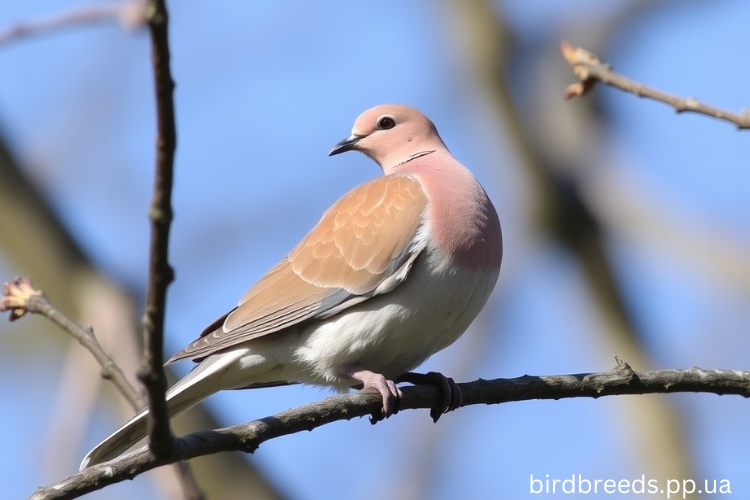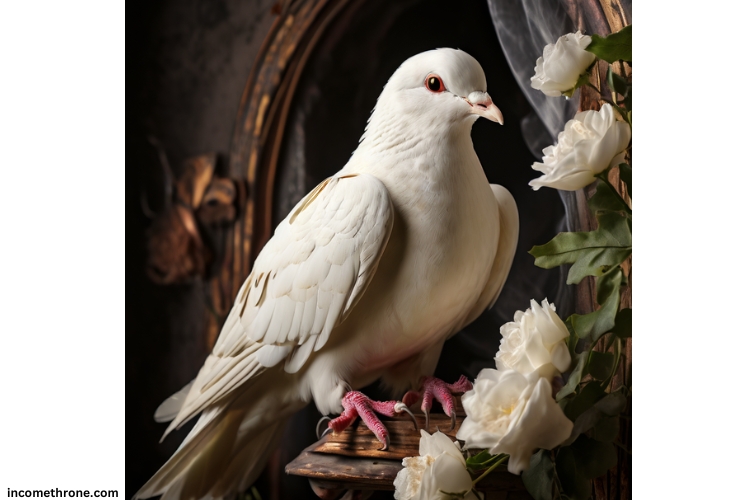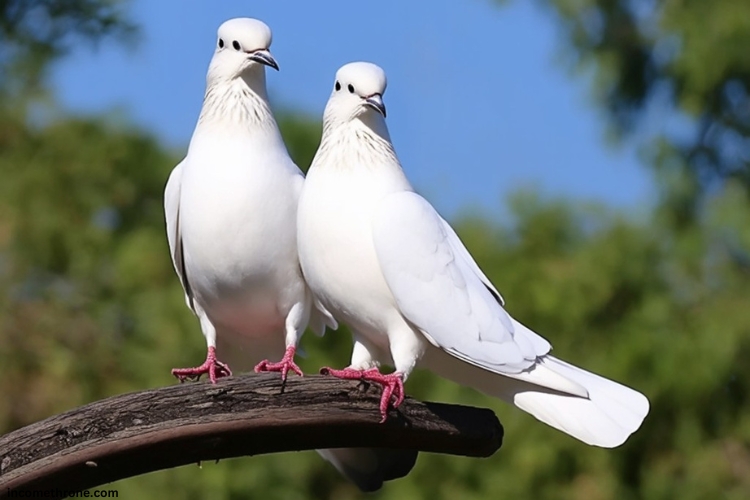Doves, known for their gentle and soothing coos, are a diverse group of birds with varying vocal characteristics. In this blog post guide, we will explore the noise levels of different dove species, examining their vocal patterns, the implications of their calls, and the behavioural and emotional contexts of their vocalizations.
Through a detailed analysis, we aim to understand whether doves are indeed loud and how their calls serve them in the wild.
Key Takeaways
- Dove vocalizations vary significantly among species, with wood-doves showing longer initial pauses between notes and tambourine doves exhibiting individually specific patterns.
- The noise levels of dove calls can be moderate, such as the blue-headed wood-dove’s song reaching 79-85 dBA SPL at 1 meter, indicating that doves are not necessarily loud.
- Size and weight differences among species, such as the blue-headed wood-dove being 64% larger than the tambourine dove, do not always correlate with the frequency of their songs.
- Dove vocalizations serve various purposes, including territorial defense, as observed in blue-headed wood-doves, and male-male competition, as noted in collared doves.
- Changes in a dove’s vocal repertoire can be indicative of its health status, with a decrease in variety potentially signaling illness.
Vocal Characteristics of Different Dove Species
The Unique Song Patterns of the Wood-Dove
The blue-headed wood-dove exhibits a song that is not only a means of communication but also a marker of individuality. Each bird’s song is distinct, with variations in note sequences that are unique to the individual. This specificity is evident in the song’s structure, which, despite its simplicity, carries significant information for mate attraction and territory defense.
In terms of song composition, the wood-dove’s vocalizations are characterized by a series of whistle syllables. These syllables increase in rate as the song progresses, with initial pauses between notes that are longer and gradually shorten. The song’s decibel levels range from 79 to 85 dBA SPL at a distance of one meter, indicating a moderately loud call that can be heard over considerable distances.
The role of these vocal patterns extends beyond mere communication; they are integral to the life history of the species. Males are known to occupy and defend their territories for extended periods, possibly their entire lives. The breeding season is influenced by food availability rather than weather, suggesting a strong link between ecological factors and vocal behavior.
Tambourine Dove Vocalizations and Individuality
The Tambourine Dove (Turtur tympanistria) is known for its simple yet individually specific songs, which have been a subject of interest in recent studies. Each bird’s song contains a unique pattern of pauses and notes, creating a distinct auditory signature that can be used for individual identification. This phenomenon was highlighted in a study by Osiejuk et al. (2019), which emphasized the species’ ability to maintain a consistent vocal pattern over time.
Researchers have found that the Tambourine Dove’s song structure is not only unique to each individual but also remains stable across different contexts.
This stability suggests that the vocalizations play a significant role in social interactions, potentially aiding in mate recognition and territorial disputes. The following table summarizes key aspects of the Tambourine Dove’s song characteristics:
| Feature | Description |
|---|---|
| Pattern | Individually specific grouping of two or three notes |
| Stability | Consistent pattern over time and context |
| Function | Social interactions such as mate recognition and territoriality |
Intriguingly, despite the simplicity of their songs, Tambourine Doves exhibit a remarkable level of vocal individuality. This contrasts with the more complex songs of other dove species, where individuality is often conveyed through a wider range of frequencies and note sequences. The ability of Tambourine Doves to convey identity through minimal variations is a testament to the nuanced communication strategies within the avian world.
Comparative Analysis of Dove Songs Across Species
The study of dove vocalizations reveals a complex tapestry of sounds that vary not only between species but also among individuals within a species. Comparative analyses have shown that doves can discriminate between neighbors and strangers based on song frequency, supporting the ‘dear enemy’ hypothesis which suggests that familiar individuals are treated less aggressively than unknown ones, reducing the cost of territory defense.
In a study comparing Perch-Coo vocalizations, researchers found statistically significant differences in the acoustic properties of songs between species. For instance, the blue-headed wood-dove’s song is highly repeatable and reflects the male’s body size, with a negative correlation between frequency and size. This acoustic fingerprint allows for individual recognition and territorial maintenance.
The table below summarizes key differences in vocal patterns between two closely related dove species:
| Species | Note Timing Pattern | Habitat | Individual Variation |
|---|---|---|---|
| Tambourine Dove | Regular intervals | Acoustically similar | High |
| Blue-Headed Wood-Dove | Irregular intervals | Acoustically similar | Extremely high |
These findings underscore the importance of vocal communication in doves and suggest that habitat acoustics play a significant role in the evolution of their songs. Further research is needed to understand the full implications of these vocal differences on dove behavior and ecology.
Noise Levels and Their Implications
Measuring the Decibels of Dove Calls
The quest to quantify the loudness of dove calls involves precise measurements using specialized equipment. Sound pressure levels are typically gauged in decibels (dB), a unit that expresses the intensity of sound. For instance, the blue-headed wood-dove’s song has been recorded at an average amplitude of 82
dB at a distance of one meter, using a CHY 650 digital sound level meter. This measurement provides a baseline for comparing the vocal output of different dove species.
To ensure accuracy, recordings are often taken with high-quality equipment and then analyzed with sophisticated software. For example, Avisoft SASLab Pro and Raven Pro are tools commonly used in bioacoustics research to assess bird vocalizations. These analyses can reveal not just the volume, but also the purity and complexity of the tones produced by doves.
Here is a summary of the average decibel levels for various dove calls, as measured in controlled studies:
| Dove Species | Average Decibel Level (dB) |
|---|---|
| Blue-headed Wood-Dove | 82 |
| Tambourine Dove | TBD |
| African Collared-Dove | TBD |
It’s important to note that these figures can vary depending on the context of the call, such as territorial displays or mating rituals. The decibel levels can also be influenced by the dove’s immediate environment and the presence of background noise.
The Impact of Size and Weight on Vocal Volume
In the study of dove vocalizations, a clear pattern emerges: larger doves tend to produce lower-frequency calls. This relationship between body size and song pitch is consistent with the theoretical prediction that larger structures are more effective at producing and resonating lower frequencies. However, within species, the correlation is less clear-cut, with some studies finding the expected negative correlation between size and pitch, while others report no correlation or even the opposite.
To further understand this phenomenon, consider the following table summarizing key findings from research:
| Study Reference | Body Size Correlation | Song Pitch Correlation | Notes |
|---|---|---|---|
| Linhart & Fuchs (2015) | Negative | Negative | Reflects body size and influences response to rivals |
| Beecher et al. (2000) | Not specified | Related to territory tenure | Correlates with song sharing |
The variability in adult body size among small songbirds, known for their pronounced vocal abilities, may challenge the size-pitch relationship. Nonetheless, when a negative correlation is present, it can affect the birds’ responses to playback stimuli, indicating that song frequency is not only a byproduct of physical attributes but also carries significant information for avian communication.
Song Frequency and Habitat Propagation
The transmission of dove songs through their habitats is a complex interplay of acoustics and environmental factors. Song frequency is a critical component in how effectively a call propagates, with lower frequencies often traveling further in dense environments like forests. This is exemplified by the wood-dove, whose low-frequency calls can be heard by human observers from considerable distances, ensuring mate attraction and territory defense.
Research has shown that song frequency not only carries information about the dove’s size but also has implications for individual recognition and rival response. For instance, a study found that doves respond more aggressively to unfamiliar songs, which suggests that frequency patterns within songs are used for identifying individuals. This is supported by findings that song pitch correlates with body size, influencing interactions with potential competitors.
To further understand these dynamics, here is a summary of key findings:
- Larger doves generally produce lower-frequency calls.
- Song frequency can be highly repeatable for individual males, reflecting their body size.
- Doves can distinguish between familiar and unfamiliar songs, affecting their behavior.
These points underscore the importance of considering both the physical attributes of doves and the acoustic properties of their habitats when studying their vocalizations.
Behavioral Context of Dove Vocalizations
Territorial Calls and Longevity of Blue-Headed Wood-Doves
The territorial calls of blue-headed wood-doves are a testament to their long-term attachment to a specific area, often presumed to be for their entire lives. Males are known to defend their territories vigorously, singing from treetops with song posts typically separated by at least 100–150 meters.
The breeding season, influenced more by food availability than weather, sees these males producing a moderately loud song, ranging from 79 to 85 dBA SPL at 1 meter.
Blue-headed wood-doves exhibit a phenomenon known as the dear enemy effect, where individuals show stronger responses to unfamiliar songs than those of their neighbors.
This suggests a sophisticated level of individual recognition, crucial for maintaining long-standing territorial boundaries. Our studies indicate that the frequency of a male’s song is highly consistent and inversely related to body size, serving as a reliable indicator for territorial defense strategies.
| Behavior | Description |
|---|---|
| Territorial Defense | Stronger response to stranger’s songs compared to neighbors’ |
| Song Consistency | Extremely repeatable frequency reflecting body size |
| Territory Tenure | Likely life-long, with well-established neighbor relations |
These vocalizations are not just a means of defending territory but also play a role in mate attraction, underscoring their importance in the species’ social structure. The blue-headed wood-dove’s reliance on vocal signals is particularly notable given their habitat in dense rainforests where visual contact is often obstructed.
Ground-Doves: Shy Vocalizers in Dense Foliage
The Maroon-chested Ground-Dove is a species that exemplifies the elusive nature of ground-doves in dense habitats. Observers often report that these birds are more often heard than seen, their soft cooing emanating from the thick foliage where they remain well-concealed.
When spotted, they exhibit a behavior akin to a ‘shy woodpecker‘, moving to the opposite side of a tree trunk to avoid detection. This behavior not only reflects their shy nature but also a survival strategy to evade predators and maintain a low profile.
Field observations suggest that the Maroon-chested Ground-Dove is particularly sensitive to the presence of observers. In Costa Rica, for instance, birders have noted that these doves may cease vocalizing or alter their position when they sense they are being watched. Despite their secretive ways, dedicated watching can yield sightings, especially of males in flight displaying their distinctive coloration.
The following table summarizes key observations of the Maroon-chested Ground-Dove’s behavior:
| Behavior | Description |
|---|---|
| Vocalization | Soft cooing from dense foliage |
| Evasion | Moves around tree trunk to avoid being seen |
| Visibility | More often heard than seen |
| Flight Sightings | Males display dark chest and pale head |
These insights into the behavior of ground-doves in their natural habitat contribute to our understanding of how these birds communicate and interact within their environment.
The Role of Vocalizations in Male-Male Competition
In the intricate world of dove communication, vocalizations play a pivotal role in male-male competition. Males utilize their calls not only to attract mates but also to assert dominance and territorial boundaries. The intensity and frequency of these vocal displays can be a decisive factor in establishing hierarchy among males. For instance, the collared dove (Streptopelia decaocto) exhibits significant variability in its song patterns during competitive interactions, which has been linked to the causes and consequences of such vocal contests.
When a male dove perceives the intrusion of a potential rival, it faces a strategic choice: to continue singing from its current location, thereby reinforcing its claim over the territory, or to approach the intruder, often at the cost of ceasing its vocal display. This decision is not taken lightly, as the act of singing involves a commitment to a long and conspicuous performance, making it difficult for the male to stop once it has begun. The table below summarizes the observed responses of male doves to the playback of songs from neighbors and strangers, indicating the complexity of their decision-making process in the face of competition.
| Response Type | Description |
|---|---|
| Stationary Singing | Maintaining position and song level, signaling territory ownership without escalating conflict. |
| Cautious Silence | Ceasing to sing without approaching, possibly perceiving the rival as too strong. |
| Prompt Approach | Quickly approaching after initial song, indicating a strong response and less time spent singing. |
These vocal strategies are not only about the immediate confrontation but also about long-term positioning within the social hierarchy. The outcome of these vocal duels can have lasting effects on the reproductive success and survival of the individuals involved.
Observations of Dove Interactions and Vocal Activity
Field Notes on Ground-Dove Behavior and Noise
During observations, ground-doves were noted to hoot and coo from within the dense foliage, a behavior typical for these elusive birds. When sensing an observer’s presence, they exhibit a ‘shy woodpecker’ maneuver, discreetly moving to the opposite side of the trunk to remain unseen.
Visual encounters with these doves are fleeting, yet a perched male was briefly observed, providing a glimpse into their subtle presence. More dynamic were the sightings of two males in flight, one particularly memorable for its stark color contrast; a dark, wine-colored chest set against a ghost-pale head.
The vocal activity of ground-doves in their natural habitat can be summarized as follows:
- Infrequent but distinct hooting and cooing
- Tendency to vocalize from a concealed position
- Quick to retreat and reposition when approached
These field notes underscore the ground-dove’s preference for secrecy and its adeptness at avoiding detection, both visually and acoustically.
Perched and In-Flight Vocal Displays
Dove vocalizations exhibit notable differences when comparing perched to in-flight behavior. Perched doves tend to have a more stable and continuous song output, which contrasts with the more sporadic and responsive vocal patterns observed during flight.
This distinction is particularly evident during simulated territorial intrusions, where the number of flights and songs can vary significantly.
In-flight vocal displays are often a reaction to external stimuli, such as the presence of a rival or a predator. The rapidity of approach and the intensity of the vocal response are key indicators of a dove’s territorial behavior.
For instance, a study on dove responses to playback revealed that males with a stronger territorial claim would approach the source of the song more quickly and engage in vocal displays after every song.
The following table summarizes the principal components (PC) analysis of dove responses to playback:
| PC1: Approaching | PC2: After Playback Response |
|---|---|
| Rapid approach, stays close to speaker | Higher number of flights and songs |
| Lower PC1 values indicate stronger territorial behavior | Higher PC2 values suggest a faster return to normal activity |
These findings underscore the complexity of dove communication and the importance of considering both the context and the mode of vocalization when studying these birds.
Acoustic Differences Between Conspecific and Allospecific Calls
The study of vocalizations among doves reveals a complex acoustic landscape where individual recognition plays a pivotal role. Birds often use vocal signals to distinguish between familiar conspecifics and unfamiliar allospecifics, a behavior known as neighbor-stranger discrimination (NSD). This ability is crucial for maintaining territory boundaries and social hierarchies within species.
In a comparative analysis, researchers observed that doves exhibit different responses when exposed to the calls of neighbors versus strangers. The calls themselves possess unique time-frequency patterns that are not only species-specific but also individual-specific. These patterns facilitate the recognition process and influence dove behavior accordingly.
To illustrate the significance of these acoustic differences, consider the following table summarizing the findings from a playback experiment:
| Playback Type | Response Intensity | Aggression Level |
|---|---|---|
| Neighbor Call | Moderate | Low |
| Stranger Call | High | High |
The table clearly shows that doves respond more aggressively to stranger calls, indicating a heightened state of alertness and territorial defense. Such findings underscore the importance of vocalizations in the daily lives of doves and their interactions with both conspecifics and allospecifics.
Emotional Expressions and Health Indicators in Dove Calls
Do Doves Exhibit Emotions Through Their Calls?
The question of whether doves express emotions through their vocalizations is a fascinating one. Birds, including doves, are capable of experiencing a range of emotions, from happiness to stress. Vocalizations are one of the primary ways doves communicate, and subtle changes in their cooing may indicate different emotional states.
For instance, a pair of doves may engage in low, raspy coos as a form of affectionate greeting when reuniting at the nest. This behavior suggests that doves use their calls not only for basic communication but also to convey affection and maintain social bonds. Moreover, variations in song frequency have been linked to the ‘dear enemy’ phenomenon, where doves modulate their calls to distinguish between familiar neighbors and unknown intruders, further implying an emotional context to their vocalizations.
To better understand the emotional expressions in dove calls, consider the following observations:
- Doves show affection through gentle coos when reuniting with their mate.
- Exploratory biting in young birds can be a sign of curiosity, not aggression.
- Changes in vocal repertoire may signal different emotional states or even health issues.
Vocal Repertoire Changes as a Sign of Illness
Changes in the vocal repertoire of doves can be indicative of health issues. A decrease in the complexity or size of a dove’s song may suggest that the bird is experiencing stress or illness. This phenomenon has been documented in studies such as the one by de Kort & ten Cate, which observed a repeated decrease in vocal repertoire size in Streptopelia doves.
Birds, including doves, may exhibit various signs when they are not feeling well. For instance, a bird that is normally vocal might suddenly become quieter, or its calls may sound strained or have ‘voice-cracks’. These alterations can be subtle and require careful observation to detect. According to PetMD, signs of stress in birds can range from biting and feather picking to decreased vocalization.
The following table summarizes potential indicators of illness in doves based on vocal changes:
| Indicator | Possible Reason |
|---|---|
| Reduced Song Complexity | Illness or Genetic Defect |
| Quieter Calls | Physical Defect of Syrinx |
| ‘Voice-Cracks’ | Stress or Illness |
| Incomplete Songs | Learning the Wrong Song |
It is essential for bird enthusiasts and researchers to be aware of these signs to ensure the well-being of doves in their natural habitat or in captivity.
Conclusion
In summary, the noise levels of different dove species vary significantly, with some like the territorial blue-headed wood-dove producing moderately loud songs reaching 79–85 dBA SPL at 1 meter, while others maintain a more subdued presence in their habitats. The vocalizations of doves are not only a means of communication but also a reflection of their behavioral patterns and environmental adaptations.
From the rhythmic progression of the wood-dove’s song to the individually specific patterns of the tambourine dove, these birds exhibit a fascinating array of acoustic characteristics.
Despite their differences in size, weight, and habitat, the frequency ranges of their songs are surprisingly similar, suggesting an optimization for habitat propagation. This study of dove vocalizations reveals a complex soundscape that is as varied as the species themselves, providing insight into the ecological niches they occupy and the roles their calls play in their daily lives.
Frequently Asked Questions
Are doves generally loud birds?
Doves are not typically considered loud birds. However, the volume of their calls can vary among species and individual birds. For example, territorial blue-headed wood-dove males produce a moderately loud song, ranging from 79 to 85 dBA SPL at 1 meter.
How do dove vocalizations differ between species?
Dove vocalizations can differ significantly between species. For instance, wood-doves have a song pattern where pauses between notes shorten as the song progresses, while tambourine doves have individually specific patterns. The frequencies of their songs may be optimized for habitat propagation, despite size differences.
Do doves exhibit individuality in their vocalizations?
Yes, some dove species exhibit individuality in their vocalizations. The tambourine dove, for example, has a song with pauses that follow an individually specific pattern, resulting in a unique series of notes for each bird.
Can the size and weight of a dove affect its vocal volume?
Yes, the size and weight of a dove can influence its vocal volume. Larger species, like the blue-headed wood-dove, which is about 64% larger in body mass than the tambourine dove, can produce louder calls.
Are there any emotional expressions in dove calls?
Birds, including doves, are capable of experiencing emotions, and it is possible that certain vocalizations may be expressions of their emotional states, such as happiness, fear, or stress.
What changes in a dove’s vocal repertoire could indicate illness?
A decrease in the vocal repertoire size of a dove could be an indicator of illness or stress. Observing changes in the complexity or frequency of calls may suggest health issues.














